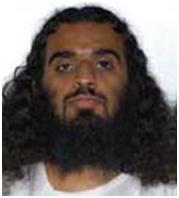|
|
|
Yousef al-Shihri, a former Gitmo detainee and now a member of al Qaeda in the Arabian Peninsula. Photo courtesy of the NEFA Foundation. |
On Oct. 13, a former Guantanamo detainee named Yousef Mohammed al Shihri was killed in a shootout at a checkpoint along the Saudi-Yemeni border. Al Shihri and his accomplices were stopped by Saudi security forces after their suspicious behavior drew attention.
Two of the travelers, including al Shihri, were reportedly dressed as women. Saudi security personnel decided to search the al Qaeda car and its passengers, but al Shihri and the others opened fire. Al Shihri and one other al Qaeda member were killed in the shootout, while a third was arrested. One Saudi security officer was also killed.
Al Shihri’s death comes just weeks after one of his al Qaeda colleagues, Fahd Saleh Suleiman al Jutayli , was similarly killed in a shootout between the Yemeni Army and Houthi rebels in northern Yemen. Shortly thereafter, Al Shihri called his family in Saudi Arabia to tell them of al Jutayli’s death and to ask them to inform al Jutayli’s family.
The Saudi security personnel who searched al Shihri’s car reportedly found a small cache of arms, including suicide explosive belts. According to a spokesman for the Saudi Interior Ministry:
An initial inspection showed two of them wearing explosive belts ready to be detonated, besides a number of hand grenades. A number of other grenades and automatic weapons as well as materials suspected of being for use to manufacture and prepare explosives were also found inside the car.
That Yousef Mohammed al Shihri returned to jihad after being released from Guantanamo is not surprising given what the US government alleged about him in three memos written between Sept. 25, 2004 and Oct. 12, 2006.
The publicly-available documents do not include any record of al Shihri attending his combatant status review tribunal (CSRT) or administrative review board (ARB) hearings, so it is not clear if al Shihri attempted to answer all of the allegations against him. However, the US government’s memos note that when al Shihri was challenged with the inconsistencies in his cover story and his lies concerning his time in Afghanistan, he “flatly refused to cooperate” and “told more lies.” It is therefore possible that he never attended either his CSRT or ARB hearings, both of which required voluntary participation.
According to the US military and intelligence officials who investigated al Shihri’s case, he was a committed jihadist who left his home for Afghanistan in early 2001.
Al Shihri’s decision to fight in Afghanistan was allegedly influenced by a recruiter who extolled the virtues of jihad at mosques inside Saudi Arabia. En route to Afghanistan, al Shihri traveled through Damascus, Syria and then Tehran and Mashhad inside Iran. This is a known al Qaeda transit route that is used to smuggle jihadists into Afghanistan and Pakistan.
Once in Pakistan, al Shihri allegedly received assistance from the Jamaat Tablighi – an Islamic preaching group that has been co-opted, at least in part, by al Qaeda. Taliban and al Qaeda members frequently use Jamaat Tablighi’s resources for traveling to and from South Asia. Al Shihri allegedly received the assistance of the head of a Tablighi mosque in Pakistan en route to Afghanistan.
Once in Afghanistan, US intelligence officials claimed, al Shihri was trained at the notorious al Farouq camp, which was the crown jewel of al Qaeda’s and the Taliban’s pre-9/11 training infrastructure. He then allegedly fought with the “the Arab Corps of the Taliban Northern Army” near Konduz, Afghanistan.
The “Arab Corps” is most likely a reference to the Arab Brigade 055, which was headed by top al Qaeda operative Abdul Hadi al Iraqi. The Arab Brigade’s members fought alongside the Taliban for years. The group was disbanded in late 2001 after the US-led invasion, but it has since been reconstituted as al Qaeda’s “Shadow Army.” In addition to fighting the Northern Alliance, Al Shihri’s duties for this “Arab Corps” allegedly included burying the Taliban and al Qaeda dead.
At one point in US custody, al Shihri allegedly admitted that he was on the front lines of the fighting both before and after the September 11 attacks. Al Shihri explained to his interrogators that afterwards “the fighting on the front became intense.”
|
Said Ali al Shihri, former Guantanamo detainee and deputy leader of al Qaeda in Yemen. Photo from The SITE Institute. |
Yousef Mohammed al Shihri was repatriated to Saudi Arabia in November 2007 along with thirteen other Saudi citizens. At least several of them have returned to al Qaeda’s ranks. One of those who rejoined al Qaeda is Said Ali al Shihri, who has become the deputy chief of al Qaeda in the Arabian Peninsula and was reportedly involved in the September 2008 attack on the US embassy in Sanaa, Yemen. According to memos prepared at Gitmo, Said Ali al Shihri is Yousef Mohammed al Shihri’s brother. However, according to a report by Caryle Murphy in the Christian Science Monitor, Saudi authorities have said the two al Qaeda terrorists were brothers-in-law.
Regardless, Yousef and Said were relatives. And their stories demonstrate the pitfalls of the US government’s transfer and release decisions. Prior to their transfers, US intelligence officials at Guantanamo had determined that Said was “a known al Qaeda operative.” Moreover, when they inquired about Yousef, they found that he was considered one of the more dangerous Saudis held at Guantanamo.
In a memo prepared at Guantanamo, US intelligence officials reported that:
A foreign government service provided information on detainees held at Guantanamo Bay that they designated as being high priority targets, in order of precedence. [Yousef Mohammed al Shihri] is number four on the list.
The “foreign government service” is likely Saudi intelligence, as that organization would have the most information on Yousef and his fellow Saudi al Qaeda compatriots. Well more than 100 Saudis were detained at Guantanamo, so Yousef must have been considered especially dangerous to be listed as number four on the list.
In addition, US intelligence officials alleged that Yousef Mohammed al Shihri made his allegiances and animosity for America well-known long before being transferred to Saudi Arabia. Regarding Yousef Mohammed al Shihri, memos prepared at Guantanamo alleged:
The detainee stated he considers all Americans his enemy. The detainee decided that he hates all Americans because they attack his religion, Islam. Since Americans are the detainee’s enemy, he will continue to fight them until he dies.
The detainee pointed to the sky and told the interviewing agents that he will have a meeting with them in the next life.
The detainee stated that the FBI, the United States and the interrogators are the enemy.
Despite all of this, Yousef and Said were transferred to Saudi custody. They both graduated from the Saudi jihadist rehabilitation program and then joined nine others in a planned escape from Saudi soil. They fled to Yemen, where they joined al Qaeda in the Arabian Peninsula, which is currently one of the strongest al Qaeda branches. Said lives on to fight another day, while Yousef now gets to test his theory of the afterlife.










12 Comments
I call this a good end to bad news.
Bill, great post.
Has there been any kind of update on what exactly the previous ex-Gitmo detainee, al Jutayli, was up to at the time of his death? Was he fighting as a jihadist mercenary for the government or had he thrown in with the rebels?
He hated all Americans, and so was trawling along the Yemeni border was he?
Obviously the holy warriors rely on the guidance of god rather than grid maps.
It might useful to keep a list of ex-Gitmo detainees who have gone on to further Jihad in some way.
It would make a useful reference for other news sources (and counter the “the innocent guys” at Gitmo propaganda).
Has anyone calculated the recidivism rate of GITMO detainees and how many innocent people have died as a result.
The Thunder Run has linked to this post in the blog post From the Front: 10/22/2009 News and Personal dispatches from the front and the home front.
The only problem with this is that some bloody journalist will say that the ex-detainee was an innocent whose incarceration in Gitmo led him into being a jihadist after being released.
Another club-gitmo member turn in his tee-shirt and meets his maker. Good riddance.
He hated all Americans, and so was trawling along the Yemeni border was he?
Obviously the holy warriors rely on the guidance of god rather than grid maps.
This guy sounds like one of the “worst of the worst” that Cheney’s always talking about. Any reason the Bush administration released him in 2007?
He died with his heels on…
About 650 detainees were released by Bush. The recidivism rate is a lot lower than for our own prison population. It is hard to get a definite count on them as the Pentagon lumps all who have been arrested as “returned to jihad” many are automatically arrested when they return home